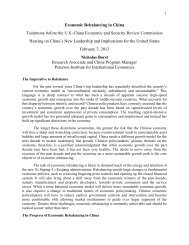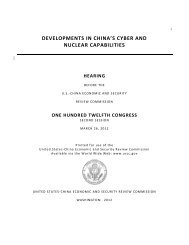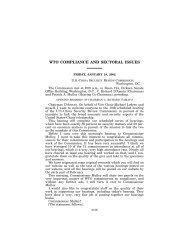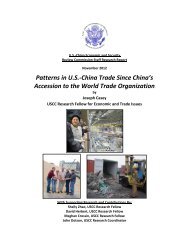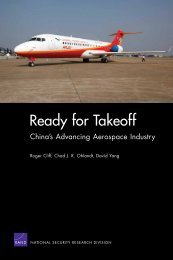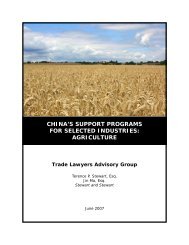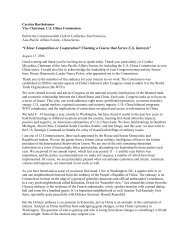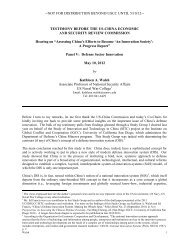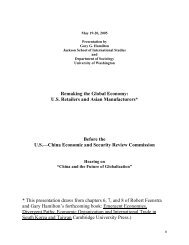2011 report to congress - U.S.-China Economic and Security Review ...
2011 report to congress - U.S.-China Economic and Security Review ...
2011 report to congress - U.S.-China Economic and Security Review ...
You also want an ePaper? Increase the reach of your titles
YUMPU automatically turns print PDFs into web optimized ePapers that Google loves.
50Political Power of the State-ownedCompany Sec<strong>to</strong>r—ContinuedThe most recent manifestation of this trend came with the announcement,in March <strong>2011</strong>, that <strong>China</strong> Petroleum <strong>and</strong> ChemicalCorporation (Sinopec) Chairman Su Shulin was set <strong>to</strong> becomethe next governor of Fujian Province. The Financial Timesnoted that ‘‘<strong>China</strong>’s oil companies have been a breeding groundfor state leaders, including current security chief ZhouYongkang, formerly at CNPC. It is not uncommon for the headsof major Chinese state-owned companies <strong>to</strong> move in <strong>and</strong> out ofgovernment, <strong>and</strong> the role of energy companies underscores therole that <strong>China</strong>’s state-owned oil companies play in national security.’’143According <strong>to</strong> Cheng Li, senior fellow at The Brookings Institution,while the proportion of <strong>China</strong>’s large enterprises in the nationalleadership is still relatively small, the rise of state entrepreneursmay broaden the ‘‘channel of political recruitment’’ in<strong>China</strong> <strong>and</strong> become a new source of the CCP leadership. 144U.S. Investment in <strong>China</strong>Over the past three decades, <strong>China</strong> has been the largest recipientamong developing countries of FDI,* with a cumulative $854 billion(s<strong>to</strong>ck)† by 2008. In just 2010 alone, the amount of FDI flowingin<strong>to</strong> <strong>China</strong> jumped <strong>to</strong> $105.7 billion, up from $90 billion in 2009. 145‘‘In the modern his<strong>to</strong>ry of economic development, no other countryhas ever benefitted, <strong>and</strong> continues <strong>to</strong> benefit, from FDI as much as<strong>China</strong>,’’ notes a study by Yuqing Xing of the National Graduate Institutefor Policy Studies in Tokyo. 146 The study estimates that‘‘foreign-invested firms have been the major contribu<strong>to</strong>r <strong>to</strong> [<strong>China</strong>’s]drastic export expansion’’ <strong>and</strong> have accounted for 40 percent of <strong>China</strong>’sGDP since 1978. 147 ‘‘It is the technologies, product designs,br<strong>and</strong> names <strong>and</strong> distribution networks of multinational enterprisesthat have removed hurdles <strong>to</strong> made-in-<strong>China</strong> products,helped these products enter the world market, <strong>and</strong> strengthenedthe competitiveness of Chinese exports,’’ notes Dr. Xing’s study. 148dkrause on DSKHT7XVN1PROD with $$_JOB* FDI is investment <strong>to</strong> acquire a ‘‘long-term relationship <strong>and</strong> reflecting a lasting interest <strong>and</strong>control’’ in an enterprise operating in an economy other than that of the inves<strong>to</strong>r. It is the sumof equity capital, reinvestment of earnings, other long-term capital, <strong>and</strong> short-term capital asshown in the balance of payments. There are two types of FDI: inward FDI <strong>and</strong> outward FDI,resulting in a net FDI inflow (positive or negative) <strong>and</strong> s<strong>to</strong>ck of FDI, which is the cumulativenumber for a given period. FDI excludes most portfolio investment, which is usually investmentthrough the purchase of shares of an insufficient number <strong>to</strong> allow control of the company orits board of direc<strong>to</strong>rs. A foreign direct inves<strong>to</strong>r may acquire voting power or control of an enterprisethrough several methods: by incorporating a wholly owned subsidiary or company (e.g.,a ‘‘greenfield’’ investment); by acquiring shares in an associated enterprise; through a mergeror an acquisition of an unrelated enterprise; or by participating in an equity joint venture withanother inves<strong>to</strong>r or enterprise. For more information, see UNCTAD [United Nations Conferenceon Trade <strong>and</strong> Development], World Investment Report 2010: Investing in a Low Carbon Economy‘‘Methodological Note’’ (New York <strong>and</strong> Geneva: United Nations, 2010); <strong>and</strong> World Bank, ‘‘ForeignDirect Investment.’’ http://data.worldbank.org/indica<strong>to</strong>r/BX.KLT.DINV.CD.WD.† FDI s<strong>to</strong>ck is the cumulative value of the capital <strong>and</strong> reserves attributable <strong>to</strong> the parent enterprise(the inves<strong>to</strong>r). FDI flows comprise capital provided by a foreign direct inves<strong>to</strong>r <strong>to</strong> anFDI enterprise, or capital received from an FDI enterprise by a foreign direct inves<strong>to</strong>r (thesedata are commonly compiled for a given period, usually per annum). For details, see UNCTAD[United Nations Conference on Trade <strong>and</strong> Development], World Investment Report 2010: Investingin a Low Carbon Economy ‘‘Methodological Note’’ (New York <strong>and</strong> Geneva: United Nations,2010). http://www.unctad.org/en/docs/wir2010meth_en.pdf.VerDate Nov 24 2008 13:46 Nov 10, <strong>2011</strong> Jkt 067464 PO 00000 Frm 00062 Fmt 6601 Sfmt 6601 G:\GSDD\USCC\<strong>2011</strong>\067464.XXX 067464



